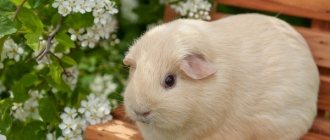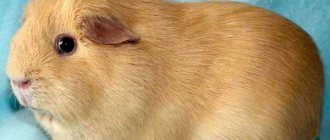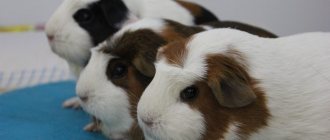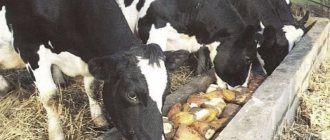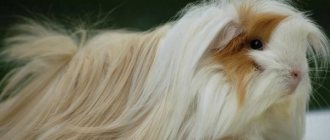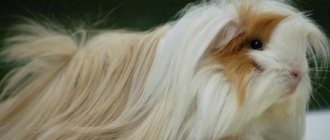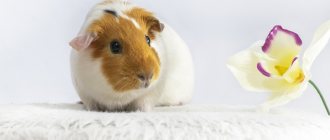The guinea pig (lat. Cavia porcellus) would probably be very surprised if she learned about its Russian-language name, because it has nothing in common with either real pigs or the sea. Then why is it called that way?
flickr/pyza*
Everything is very simple: it became “marine” because it was brought from America, i.e. from across the sea. Although it would probably be more correct to call it “overseas”. In Europe, it is most often called "Guinea pig", "pig mouse" or "Indian pig". As you can see, only the word “pig” does not cause controversy. Why? Because this animal sometimes makes grunting sounds, just like its big namesake.
The Andean tribes of South America were the first to domesticate guinea pigs 5 thousand years ago. True, then they were not just pets. People used them as a source of tasty meat or as sacrifices for various rituals and ceremonies. Since the 13th century AD. Indian tribes became seriously interested in breeding them and, before the conquest of the Inca Empire in 1533, managed to develop many different breeds.
flickr/pyza*
Of course, modern breeders have gone even further. Today there are a huge number of varieties of guinea pigs that are completely different from each other. For example, in pet stores you can find both long-haired animals, as well as wire-haired, short-haired and even animals with no hair at all or with a little fluff.
In general, guinea pigs have a body length of 25 to 35 cm, they have a wide blunt muzzle with floppy ears, a large body with rounded shapes and no tail at all. Males weigh from 1 to 1.5 kg, females - from 0.8 to 1.2 kg. In wild individuals, the natural color of the upper body is brownish-gray, the belly and the inside of the paws are lighter.
flickr/pyza*
These are quite cute pets with a good-natured and trusting character. They love to sit in their arms and play with their owner. However, during such activities you should be very careful, since a fall even from a small height can have very sad consequences for the animal.
Interestingly, guinea pigs, in addition to grunting, can make many other different sounds. For example, when they are happy, they may purr. Males sometimes purr when courting. Females, during pregnancy or in the absence of a male, begin to chirp like birds. They do this at night, continuing their “song” from 2 to 10 minutes. True, this happens extremely rarely.
flickr/pyza*
Guinea pigs eat hay, grain feed, juicy vegetables and fruits. When feeding, it should be taken into account that fresh hay should be kept in the cage around the clock, since the animal uses it to grind down its teeth, in addition, it helps to normalize the functioning of the digestive system.
Sometimes the animal can be caught in a not very pleasant procedure - eating its own droppings. He inherited this habit from his wild ancestors - it turns out that in this way guinea pigs are enriched with vitamins, since vitamins B and K are absorbed in the animal’s body only when they repeatedly pass through the gastrointestinal tract.
It is better to keep them in pairs or small same-sex groups - loneliness makes guinea pigs very worried, which leads to overeating and a shortened lifespan.
So…
History of domestication of the guinea pig
The history of domestication of the guinea pig goes back more than seven thousand years. Before the invasion of the Spaniards, the Inca tribes developed several domestic breeds, from which all modern species and subspecies of cavia originated. However, the main criterion for breeders of the past was not color and intelligence, but the taste of meat and size. To this day, the tradition of eating guinea pigs has been preserved in Peru, Ecuador and China. In Europe and the USA, cavy meat is viewed with distrust: culinary specialists admit that it is tasty and has a pleasant aroma, but classify it as exotic.
According to information that has survived to this day, cavias arrived on the European continent at the end of the sixteenth century.
They quickly gained popularity due to their cute appearance, intelligence and wide variety of colors. They got their name for sounds and squeals similar to grunting, as well as for the proportions of the body and head. Guinea pigs were named because sailors took the animals with them on long voyages. The animals take up little space, eat simple plant foods and are very fertile, plus they are a source of valuable meat.
Popular message topics
- Netherlands
The state of the Netherlands is located on the islands: Saba, Bonaire, Sint Eustatius (All these islands are otherwise called the Caribbean Netherlands), as well as on the territory of Western Europe. The territory of the Netherlands in Northern Europe is located near Belgium, - Cocoa
Each of us has tried cocoa at least once, but not everyone knows where it came from. I propose to study the history of our beloved product. What is cocoa? What is chocolate? How are they interconnected? - Buffoons
In Russia, traditions rarely went without fun, laughter and jokes. Therefore, the Russian people have always celebrated holidays widely, with songs, dances, and entertainment. This is where such merry fellows as buffoons appeared.
Appearance of pigs
A simple description of a guinea pig looks like this: a small animal with a cylindrical body, reaching a length of no more than thirty centimeters. An adult male weighs no more than two kilograms, and a female weighs about a kilogram. The head of the cavy is relatively large, the neck is poorly visible, and the legs are short. Distinctive features from the rodent order are manifested in the way the guinea pig looks, in its lifestyle, and in the duration of pregnancy. One of the most obvious distinguishing features is its very short ponytail.
In nature, they do not dig minks, but live on the surface, and pregnancy lasts up to seventy days.
However, like all representatives of rodents, caviae have a specific bite and pronounced long incisors. Incisors grow throughout their lives and it is very important to give them hard food to chew on, as well as tree branches so that the teeth can be worn down. Otherwise, excessively long teeth can damage the tongue, lips and palate. Even experienced breeders do not always know how many teeth a guinea pig has.
From birth, the animal has twenty teeth with a folded surface:
- two pairs of cuts,
- two pairs of premolars,
- three pairs of lower molars,
- three pairs of upper molars.
The animals also differ in color vision. They can distinguish yellow, green, red and blue colors, but guinea pigs have poor vision and rely little on their vision. The wild or natural color of pigs is close to black. All color forms existing today, as well as hairless and short-haired breeds, are obtained artificially.
Report No. 2
The guinea pig is a good-natured and unpretentious rodent. In addition, she does not need to be walked outside like, for example, a dog. This is one of the significant advantages, since the living conditions of some people do not allow them to have other types of animals.
Guinea pigs are absolutely not aggressive. Unlike other types of rodents, they do not have an unpleasant odor at all, if, of course, the cage is cleaned in a timely manner. This cannot be said, for example, about hamsters, which almost always have a specific smell.
Speaking about why guinea pigs have such a name, it is worth noting that they do not like to swim at all and do not know how to swim. Water poses a danger to their life and health, so you should not bathe them. This beautiful rodent is called the guinea pig because it makes sounds reminiscent of the grunting of piglets. The homeland of these animals is Peru, from where they were brought on ships from overseas. That is why they began to be called overseas pigs, now called guinea pigs.
The acquisition of this animal must be approached responsibly and thoughtfully. These animals are not flexible at all. Falling is especially dangerous for them, which can cause very serious injuries that can even kill the animal. Therefore, when holding an animal in your arms, you must be careful.
Guinea pigs are timid, fearful and harmless. It is worth noting that they need communication and in natural conditions they live in a herd. If a rodent is constantly alone and not receiving proper attention, it suffers. Therefore, even under good living conditions, you should not get a guinea pig if the owner does not devote time to communicate with it. If you have a strong desire to have a guinea pig and do not have enough time for communication, you can get several animals so that the pig does not feel lonely. If your plans do not include breeding them, then it is better to have animals of the same sex, otherwise there will be constant replenishment.
Before buying a rodent, you need to provide the animal with everything it needs, and also read literature on the proper care and feeding of guinea pigs. To keep a rodent, you need a spacious cage, a drinking bowl, two feeders (one for grain food, the other for succulent food), sawdust bedding, hay, special scissors for trimming claws and a supply of grain food for guinea pigs.
Coprophagous pigs
Animals that eat their own excrement are called coprophages. Pigs eat their droppings in a rather strange way: they curl up into a ball and swarm in the anus area, where the fecal pocket is located. Many breeders have a question: why do guinea pigs eat their litter and is it dangerous to health? Zoologists explain this behavior as follows: the pig’s body is not able to process all the amino acids contained in food. Some important amino acids and vitamins K and B leave the body along with feces. Even with vitamin supplements, the animal will continue to eat particles of droppings - there is no other way to obtain all the necessary amino acids.
In nature, pigs eat their droppings for another reason: they are very vulnerable and strive to destroy any traces of their vital activity so as not to attract the attention of predators.
Lifestyle of pigs
In nature, guinea pigs are most active in the mornings and evening twilight. They are agile, can run fast and are always on the alert. You can see kavi in both mountainous areas and forests. Guinea pigs do not dig minks, preferring to build nests in a secluded place from dry grass, fluff and thin twigs.
The social lifestyle of guinea pigs involves living in one territory with a large flock of animals. Each pack or family consists of one male and ten or twenty females. In its natural habitat, a guinea pig eats roots and seeds of plants, leaves, fallen berries and tree fruits. The lifespan of wild cavy is no more than seven years.
At home, a guinea pig can live 12-15 years.
They are kept in ordinary cages, but are provided with sufficient walking: the animal is very active and needs movement. The constant activity of the animals raises the question among some breeders: how much guinea pigs sleep and whether they sleep at all. The animal sleeps for ten to fifteen minutes several times a day. The cubs sleep for less time. If the animal is worried or feels threatened, it may sleep with its eyes open.
There are four age stages in the life of Kavya. The first is under the mother, when the cub drinks the mother's milk. From the third day, the cubs begin to try adult food, but without milk the chances of survival are zero. The second period begins at the moment when the young individual switches to independent feeding and begins to eat all the basic adult food. At home, a grown guinea pig happily eats alfalfa or clover hay, young shoots of dandelions and clover, various root vegetables, fruits, and herbs. Of the roughage, pigs prefer to eat sprouted oats, wheat, and corn grains. The third period occurs during puberty. Females are ready for fertilization at the age of eight weeks, males at twelve weeks. The fourth period is characterized by a decrease in activity and loss of reproductive function.
Keeping at home
Breeders need to constantly monitor the animal's diet and how much the pig eats. Overeating, like fasting, has a negative impact on health. Another important point that every breeder should know is what foods should absolutely not be given to cavy. These include:
- red cabbage,
- sweets,
- meat products,
- fish products,
- eggs,
- dairy products.
Despite the fact that pigs are ready to breed at a very early age, it is recommended to get the first litter from one-year-old animals. By this age, they have time to fully grow, become stronger and take shape.
Owner reviews
Naturally, high-end guinea pigs are inaccessible to ordinary buyers. In any case, if you plan to breed them, you should opt for purebred specimens.
Interesting to know! In our country, guinea pig breeding has not yet reached such a high level as abroad. Despite this, true connoisseurs of these animals try to acquire individuals that have an attractive and exotic appearance.
It should also be remembered that you cannot cross long-haired and short-haired representatives of the breeds, since the result will be offspring that are low-quality mestizos and no one will allow them to be shown at exhibitions. On top of that, crossing different breeds is also unacceptable because it hinders the improvement of the breed data of any of the species.
Guinea pigs have earned the right to be considered one of the most sought-after pets. Ease of care and maintenance is acceptable for everyone, even novice owners. This is an affectionate and sociable animal that is perfect for families with children.
Interesting information about kavias
Interesting facts about guinea pigs are not limited to their differences from rodents and their relationship to coprophages:
- the distant ancestors of the guinea pig weighed more than 600 kg,
- Cavias have 64 chromosomes (humans have only 46),
- animals make many sounds. They can squeal, snort, grunt, chirp, purr, grumble,
- Kavyas cannot stand loneliness,
- their intelligence is slightly inferior to that of dogs and cats.
What is also interesting is what a guinea pig dreams about. According to dream books, if you dream about a guinea pig, this means that a person is not able to withstand the current circumstances and has low self-esteem. However, a guinea pig sitting in your arms portends joyful events and good news.
Relatives of Kavya
Relatives of guinea pigs include beavers, squirrels, and even gophers, mice and rats. Such a large number of relatives is explained by the large number of rodents.
Among the relatives of Cavia there are many familiar and many unusual mammals:
- mara looks like a hare, but larger - weight up to 16 kg,
- agouti is an animal that resembles both a rabbit and the ancient ancestor of modern horses,
- paka - a cautious and more deer-like rodent, weighing up to 12 kg,
- The capybara is the largest representative of the order, weighing up to 60 kg, grows up to 140 cm in length, and leads a semi-aquatic lifestyle.

